Background
The Third Reich, which was spawned on January 30, 1933, was born out of the National Socialist Workers’ Party, which was the very embodiment of Adolf Hitler himself. On April 20, 1889, its Führer (Leader) was cast upon the unsuspecting world at Braunau, Upper Austria. At the age of nine he became a choirboy in the Catholic Church at Lambach, and claimed in later years that his great vocal power had developed while singing hymns. He was an average, lazy and rebellious student, with a talent for drawing. This talent decided him on a career in art. His oratorical rehearsals were not overlooked. August Kubizek, his close boyhood friend, recalled young Adolf practising elocution in an open field. From his schooldays Hitler was a fanatical German Nationalist with a rancorous hatred of others, mostly Slavic races which made up the Austro-Hungarian Empire.
Hitler’s early life
With the aim of entering the Academy of Art or the School of Architecture, Hitler moved to cosmopolitan Vienna in 1907, which at the time housed a large Jewish community. His failure in the entrance examinations was to have dire consequences for the future of Europe. Angry at his rejection, Hitler also caught the infection of anti-Semitism and became a prey to a morbid loathing of the Jews, which affected his whole outlook on life. A fierce nationalism and a corresponding intolerance of other races soon furnished Hitler with a distorted view on life from then on. His German nationalism was derived from Fichte, Hegel, Treitshed, Nietzsche and Richard Wagner. Wagner’s operas, with their emphasis on Teutonic and German mythology, had an enormous influence on him, while the writings of the philosopher Nietzsche also attracted him. Nietzsche expounded the notion of the “superman” (Ubermensch), a being perfect in mind and body who disdained man-made laws and goals, and who discarded morality for the virtue of “hardness”. In this way Nietzsche extolled the ideas of force and strength. Hitler and the Nazis would later appropriate and pervert these ideas to create a ruthless totalitarian state. In Hitler’s eyes the Nordic German hero was the archetypal superman, but he had to be freed from the shackles of Christian morality, which Hitler condemned for its Judaistic origins.
Service in World War I
In May 1913 Hitler was 25 and had moved from Vienna to Munich. By this time, he was to claim later, his character was fully formed and his fundamental philosophy was already worked out, though materially he was little better than a vagrant, making a living from selling his paintings. In January 1914, and overdue for Austrian military service, he was summoned to military service in Austria and the Munich police obliged him to return. At Salzburg he was found to be medically unfit, though, and was allowed back to Munich. In August he joined the crowds demanding action against Russia and calling for a pan-German movement against both Russia and Serbia. The Austrian Empire had already declared war against Serbia since the heir to its throne had been assassinated in the town of Sarajevo. August 1914, with the outbreak of World War I, gave the wandering Hitler an opportunity. He threw himself into it with an ardour extraordinary even in those euphoric first days. He promptly addressed a petition to the Kaiser seeking permission, although he was an Austrian, to join a Bavarian regiment.
The disability which had kept him out of the Imperial Austrian Army having been apparently overlooked, Hitler’s wish was granted. He served during World War I as an infantry volunteer in the 1st Company of the 16th Bavarian Regiment known, after its founding colonel, as the List Regiment. By October Hitler’s regiment was at the front before the town of Ypres. By his own choice he served in the dangerous role of regimental message runner for the duration of the war, refusing promotion beyond the rank of corporal. In 1914 he won the Iron Cross second class. In the regiment were Lieutenant Wiedemann and Sergeant Max Amann, both of whom later became prominent Nazi Party members. In October 1916 Hitler was injured in the thigh and sent to a military hospital in Berlin. On recovery he was sent to the reserve battalion in Munich, returning to his regiment in March 1917. The List Regiment participated in Ludendorff’s April 1918 offensive, when Hitler was awarded the Iron Cross first class for his bravery. The act of heroism for which he received his award is not known, but apparently he captured an enemy officer and about a dozen soldiers. The award to a soldier of his rank was unusual, and marked him out as a distinguished frontline soldier. In the fighting near Ypres he was blinded by gas in October 1918 and sent to hospital in Pasewalk in eastern Germany, until discharged fit and posted back to the Munich barracks in November 1918.
Post-war Germany
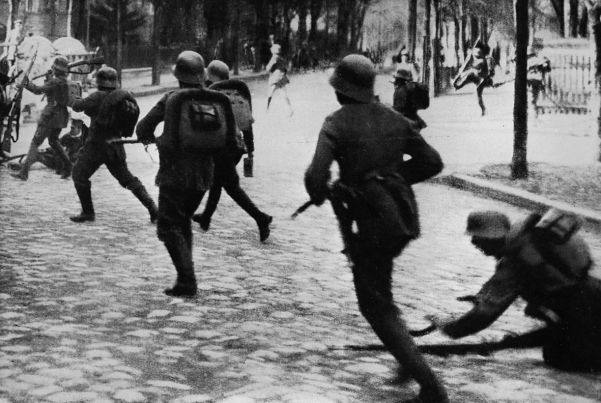
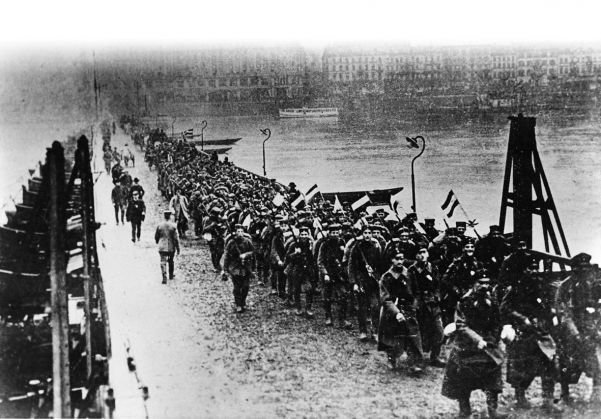
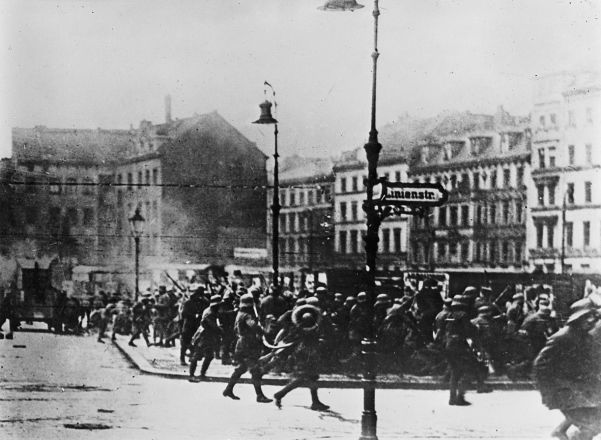
World War I ended on November 11, 1918, leaving Hitler not yet having reached Munich and Germany in chaos and revolt under the frail Weimar Republic. The chancellor of Germany was the social democrat Friedrich Ebert, who in 1919 would become president of the country. Under the terms of the armistice, the army was reduced to a 100,000-man force called the Reichswehr.
Germany was far from a united country. On the one hand, the disbanded troops and their officers viewed the new republic with distaste, while the socialists and communists were fomenting revolution, culminating in January 1919 when the Spartacist revolt broke out at the beginning of that month.
The new republic’s army decided to defend itself against subversion. Munich, for example, was first under the rule of a Bavarian socialist government, which was subsequently crushed by central government troops with the aid of its Freikorps allies. The Freikorps were groups of right-wing ex-soldiers which sprang up all over Germany following the end of the war. Essentially gangs of brutalized men whose allegiance was to their commanders only, the Freikorps fought for the elimination of all “traitors to the Fatherland”. They brutally suppressed the Spartacist revolt in Berlin, and then helped to put out the embers of left-wing revolt that had spread to other parts of Germany (ironically, the Freikorps fought with British and French approval when they fought against the Bolsheviks in Lithuania and Latvia in 1919).
The German Workers’ Party
Onto the political stage during this turbulent time appeared two luminaries, both of which Hitler would eclipse. The first was an insignificant railway locksmith, Anton Drexler. He was a harmless-looking, bespectacled man who worked with the Fatherland Party during and after World War I, whose aim was to get a fair peace for Germany. Drexler merged two tiny groups of malcontents into the Deutsche Arbeiterpartei, the German Workers’ Party, or DAP, in January 1919. It was an organization with no assets except a cigar box in which to put contributions. The second was a far more sinister character named Ernst Röhm, who could be best described as short, overweight and bullet-scarred, with flushed cheeks and a savage smile. He was a non-conformist, a roistering lecher, homosexual and adventurer who by his own admission detested bourgeois normality and felt himself drawn to exploit the chaos which engulfed Germany after her defeat. This unusual combination produced a detestable personality that was to be his ultimate undoing. He had remained in the army after the war and fought in Ritter von Epp’s Freikorps to crush the revolutionary Bavarian socialist government. He was also at this time secretly employed by the army to establish ammunition and weapons dumps in the Munich region for monarchist and nationalist groups, and to organize a special political intelligence unit for the army.
Hitler joins the DAP
Hitler, still a corporal awaiting his discharge from service, was selected for training in this new unit as an education officer in February 1919. Hitler’s deeply held nationalistic views and anti-Semitic prejudices were bolstered by the political instruction that he received during his training. In September 1919, his army intelligence masters sent him to investigate this small group. Drexler’s ideas appealed to Hitler, for he was bitterly opposed to the “capitalist Jews” and the “Marxist conspiracy” (these ideas were to form the very core of Nazi ideology). Hitler joined Anton Drexler’s German Workers’ Party in 1919. Drexler wrote confidentially to a colleague about Hitler, describing him as, “An absurd little man”, and commenting on how in such a short time Hitler had become steering committee member No 7 of the party. Drexler’s position in the party was under threat by Hitler’s forceful personality and his persuasive oratory. Hitler later wrote of Drexler in Mein Kampf: “His whole being was weak and uncertain, nor did he have the ability to use brutal means to overcome the opposition to a new idea inside the party. What was needed was one fleet as a greyhound, smooth as leather, and hard as steel.” In less than a year the “absurd little man” had become the dominant force in the party. Soon afterwards, Hitler had created the National Sozialistische Deutsche Arbeiter Partei (National Socialist German Workers’ Party - NSDAP) to succeed the DAP.
Ernst Röhm
To inflate its importance and size, Hitler massaged the membership numbers, but the party desperately needed a kick-start. Ernst Röhm, who was chief of staff to the commandant of the Munich military region, now chose to support Hitler, thus helping the fledgling Nazi Party to grow. Röhm fancifully considered himself a revolutionary and had heady ambitions of forming a revolutionary army with himself at its head. His chosen vehicle was the Bavarian Home Guard, which possessed clandestinely secreted weapons, which Röhm hoped he could use in his revolution. The Berlin government, having collected intelligence about revolutionary activity, disbanded this and other military groups who were covertly gathering in various districts of Germany in early 1921. This thwarted Röhm’s ambitions. Hitler’s embryonic Nazi Party acted as a magnet and seemed the obvious receptacle for his inflated ego (Röhm was confident he could mould Hitler to his will and usurp his powers). He courted Hitler with introductions to influential persons like General Erich Ludendorff, World War I hero and right-wing nationalist, and General Franz Ritter von Epp, the commandant of the Munich military region. These introductions subsequently bore fruit. Hitler and his party gained credibility and financial help began to materialize. Money equates to power, a fact not wasted on Hitler. He now needed to improve the party’s programme, and its visual aspect would be its best advert. Men were now used to military life and uniforms and the pageantry that went with it. What was more natural than to harness these patriotic feelings, which had been instilled and burned into them during the four years of carnage? Hitler chose the female form of the ancient swastika emblem as his symbol, and planned the design of the Nazi flag, which he described as “something akin to a blazing torch”.
SA violence
With a visual political message and growing financial support, Hitler’s party was making progress, but he needed a major confrontation with his political enemies to attract more attention.This occurred on November 4, 1921.
Hitler was informed that at the Hoffbrauhaus, the venue for a speech he was going to make that evening, the left-wing social democrats and the communists were going to try to crush his party. The meeting went ahead, but during his speech fighting broke out in the hall. Hitler later described the event poetically: “The dance had not yet begun when my stormtroopers, for so they were called from this day on, attacked like wolves. They flung themselves in packs of eight or 10 again and again on their enemies, and little by little actually began to thrash them out of the hall. After five minutes, I hardly saw one of them who was not covered with blood. Then two pistol shots rang out and now a wild din of shouting broke out from all sides. One’s heart almost rejoiced at this spectacle which recalled memories of the war.”
The Birth of the SA
In the early days of Nazism, Hitler was surrounded by the unwieldy Sturmabteilung (Storm Detachment), or SA, who were in the main tough, unemployed ex-soldiers who frequented Munich beer halls such as the Torbräukeller near the Isar Gate. They were recruited by Röhm to protect Nazi speakers at public meetings. The Brownshirts, as they became known, were party uniformed supporters who acted as bodyguards. They were to grow in number, acting under Röhm’s orders rather than Hitler’s.
The Nazi Party, being small and relatively insignificant, needed the oxygen of publicity to keep its cause alive. In 1922 there occurred an incident that kept the Nazis in the public mind and was later to become part of party folklore. Coburg’s city fathers had decided to hold a “German Day” that was to be a folk festival to encourage German rural life. Coburg’s geographical position is some 192km (120 miles) east of Frankfurt on Main and about 64km (40 miles) from Schweinfurt. The city had a population of approximately 30,000, was Marxist controlled and was largely insignificant - until October 1922.
Coburg, October 14-15, 1922
Hitler with his party were invited to the gathering (one wonders by whom considering the political persuasion of those who controlled the city), which afforded him the public platform that he so desperately needed to publicize his fledgling party. The chances of political violence were high, but the greater the disturbance, the more media attention it would attract. First, though, Hitler had to overcome an initial problem: transportation to the venue. Although without visible funds, he managed to hire a train, and the tickets bought by almost every party member who boarded the train defrayed the cost. With what was virtually the entire membership of the party - some 700 accompanied by a 42-piece band - set off from Munich in the “special train”. Such was the devotion of some of the Nazi membership that many had bought tickets with their last Reichmarks.
The Marxists mobilize
The Marxist city officials were far from elated when they perceived the full ramifications of what was descending on the carefully controlled Coburg festival. A police captain was dispatched to greet the train, who pronounced that the Nazis could not enter the city with flags flying and band playing, as this was contrary to the law. The police officer was brushed aside by Hitler, and the Nazi Party marched off in formation. Eight massive Bavarians carrying Alpenstocks and clad in lederhosen led the cortege, and formed an escort for Hitler and his confidants: Max Amann, Hermann Esser, Dietrich Eckhart, Christian Weber, Ulrich Graf, Alfred Rosenberg and Kurt Ludecke.
Word had spread concerning the approach of the Nazis and a crowd, some thousands strong, threatened to bar their way. One of its Marxist members began to throw projectiles, sparking off a furious fight which lasted approximately 15 minutes. A curious thing now happened, for the crowd began to go over to the Nazis, who proceeded to march into the town. Hitler addressed a meeting in the town hall that evening attended by the Duke and Duchess of Coburg, who were later to become active Nazis. This speech was to be hailed as one of his triumphs, and after it fights raged between Marxists and the Nazis long into the night. In the morning the city was festooned with notices calling for a “People’s Demonstration” that would eject the Nazis. The Marxists had made their move.
A legend is born
Hitler grouped his men and marched them into the city’s main square. Here, it was thought, would be gathered as many as 10,000 townsfolk waiting to annihilate them. Instead, there were only a few hundred die-hard Marxists, whose stranglehold over the city was broken before the day was out. Imperial flags were festooned from windows and the rock-throwing crowds were replaced by cheering throngs. The Marxists, reeling from the defeat, announced that they would not let the “special train” leave. Hitler, buoyed up by his victory, told the officials that he would take hostages of every communist he could find and transport them to Munich on his train. The outcome was not lost on the Marxists, who capitulated to Hitler’s demands. Hitler had won his first decisive victory. In Nazi circles the event entered folklore and led to the expression in later years: “But were you at Coburg?”
“Germany Awake”
The mass meetings continued. A party rally to be held on the outskirts of Munich on the Marsfeld was planned by Hitler during 1922 and proposed for January 27-29 the following year. It was to be the NSDAP’s largest rally to date, with 5000 SA men from all over Bavaria converging on Munich. To increase popular appeal, bands and traditional dance groups had been hired, in addition to 12 meeting halls. Also planned were marches of SA and party supporters through the streets of the city on the way to the massed meetings. This Parteitage (Party Day) was to be all-important, as Hitler’s first four Deutschland Erwache (“Germany Awake”) standards were to be consecrated on the Marsfeld along with other NSDAP flags. The government, however, became increasingly uneasy upon hearing rumours of a Putsch (coup d’état), and so a ban was issued against the outdoor ceremony of consecrating the flags and standards, plus half of Hitler’s publicly announced meetings throughout Munich. Upon hearing of these bans, Hitler flew into a rage and went to the Munich police commissioner, Eduard Nortz. Hitler demanded that the ban to be lifted, but Nortz would not be moved and reiterated that the ban would remain. Hitler shouted at the commissioner that the rally would still take place in its original form and, in the defiance of the ban, he would march at the front of the SA through the streets of Munich. Nortz convened a session of the Council of Ministers. They proclaimed a “state of emergency” which automatically banned all the activities planned for the party rally. Hitler now had only one possible solution - the Reichswehr - which was sympathetic to the National Socialists. Hitler arranged for Röhm and Ritter von Epp to persuade Lossow, its commander in Bavaria, to meet with him to discuss the situation. After the meeting Lossow informed the government that he considered “the suppression of the Nationalist Socialist organisation unfortunate for security reasons”. The ban was subsequently lifted. However, Commissioner Nortz demanded a second meeting with Hitler, where he requested that the number of meetings remained at six instead of 12 and, more importantly, Hitler was to stage the consecration of the standards and flags inside the “Krone Circus” and not outside on the Marsfeld. Vaguely, Hitler indicated compliance with the request.
1st Nazi Party Day
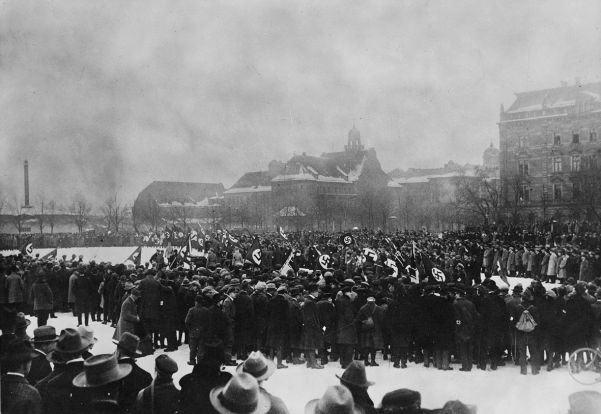
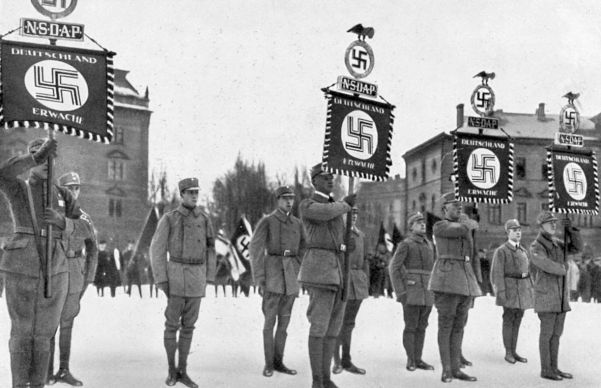
The Parteitage was held between January 27 and 29, 1923, under the slogan Deutschland Erwache. Two brigades of men marched through the city of Munich and Hitler held all 12 mass meetings. He declared the swastika would be the national symbol of the future Germany. Furthermore, he stated: “The German spirit cannot be broken in these men, Germany is awakening, the German freedom movement is on the march.’ All the party members swore to be true to the party and the man who led and guided them, i.e. Hitler. It was proclaimed that the name of this movement was the NSDAP. The consecration of the first four Deutschland Erwache standards and NSDAP flags as originally planned on the Marsfeld amidst the typical January snowy weather took place on the third day of the Parteitage of the NSDAP.
Birth of the SS, March 1923
Hitler realized the necessity of organizing a more dedicated élite personal guard. This guard should not be large, but it had to consist of men of proven calibre, of Nordic blood and of good character. They had to act as bodyguard and spearhead with an unequivocal allegiance to Hitler. They had to protect both Hitler and important members of his party while they travelled the breadth of Germany furthering the Nazi cause. The Brownshirts could be relied on to meet violence with violence, but they acted under Röhm’s orders when they acted on orders at all. Many SA were ex-Freikorps members, and they were accustomed to swearing loyalty to their immediate commander. They were too unreliable as far as Hitler was concerned; they fulfilled a short-term necessity, but for the future he needed a totally loyal Praetorian Guard. That guard would be later be the Schutzstaffel (Defence Squad), the SS.
The Stabswache (Staff Guard)
In March 1923 the embryo SS consisted of just two men - Josef Berchtold and Julius Schreck - who called themselves the Stabswache (Staff Guard). Two months later a new unit, the Stosstruppe Adolf Hitler commanded by Josef Berchtold, was formed. In August 1923 Heinrich Himmler, its future leader, joined the NSDAP.
By the autumn of 1923 Hitler had made the Nazi Party a rallying point of opposition to the government in Berlin, but he now committed a major error in trying to seize power by force rather than constitutional means. He had seen Mussolini take power in Italy in October 1922 by marching on Rome, thus why could he not do the same? Perhaps not as sole leader of right-wing forces, but certainly part of a small group that would include Ludendorff, a notable anti-republican and hero of the right.
The timing of a coup
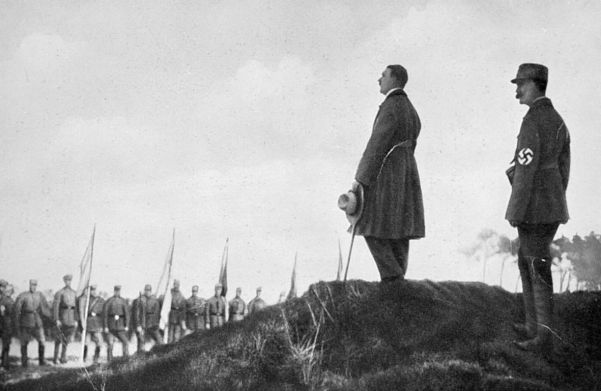
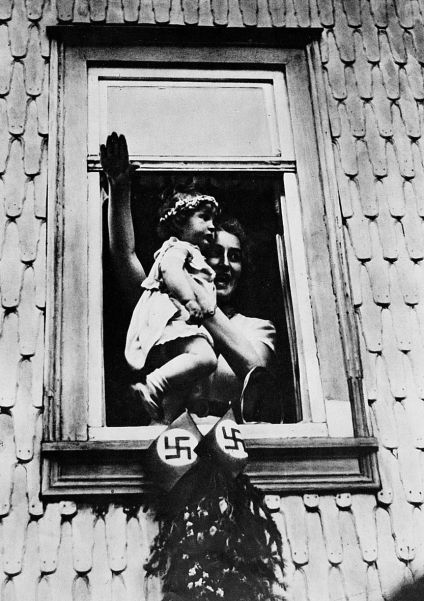
Circumstances seemed to favour a coup against the Weimar government: Germany was almost bankrupt, a fact not helped by the world slump of 1921. She defaulted on reparations payments (one of the hated clauses of the Treaty of Versailles), which prompted the French to occupy the Ruhr, the centre of German industry, in January 1923, which acted as the catalyst for destroying the value of German currency. The fault was laid at the feet of the “November Criminals”, those individuals who had signed the Treaty of Versailles, plus the communists, Jews, profiteers and social democrats who had betrayed the army during World War I - the “stab-in-the-back” theory - and who still worked for the downfall of Germany. All fanciful stuff, but very popular with ex-soldiers, serving soldiers and the vast reservoir of anti-Semitism and anti-democratic resentment that existed in Germany at the time. To Hitler and the right, the time appeared right to take power by force of arms, and restore Germany’s pride and place in the world.
Unfortunately for the Nazis, events conspired against them. A communist uprising in Hamburg was defeated on October 23, and by the end of that month the Reichswehr had defeated communists in the governments of the states of Saxony and Thuringia. This denied the Munich plotters the excuse of the threat of communism. However, as far as Hitler was concerned the die was cast: the coup would go ahead.
The eve of the uprising
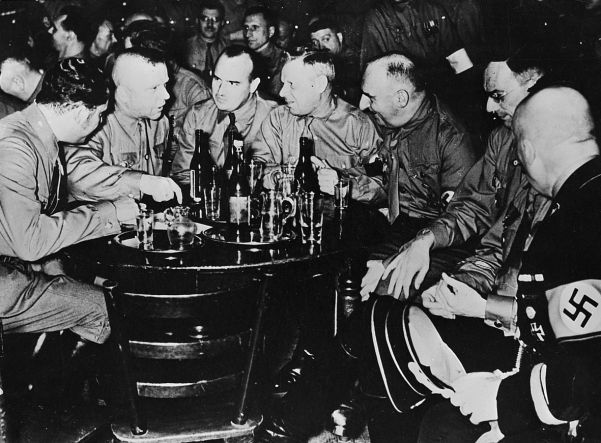
On the eve of the November 9 Munich Putsch, Gustav von Kahr, head of the Bavarian government, was to speak in the Bürgerbräukeller (Kahr was sympathetic to the right and Hitler had tried to recruit him to his cause, but Kahr had prevaricated and withdrawn his support). Unnoticed, Hitler, Max Amann, Alfred Rosenberg and Ulrich Graf took up position in the hall. After Kahr had been speaking for about 20 minutes, 25 armed Brownshirts, accompanied by Hermann Göring - World War I air ace and now commander of the SA - burst into the hall. At this moment Hitler leapt upon a chair, fired a shot into the ceiling and shouted: “The National Revolution has begun. This hall is occupied by 600 armed men. No one may leave the hall. The Bavarian and Reich Governments have been removed and a provisional National Government formed. The army and police barracks have been occupied, troops and police are marching on the city under the swastika banner.”
The Munich Putsch
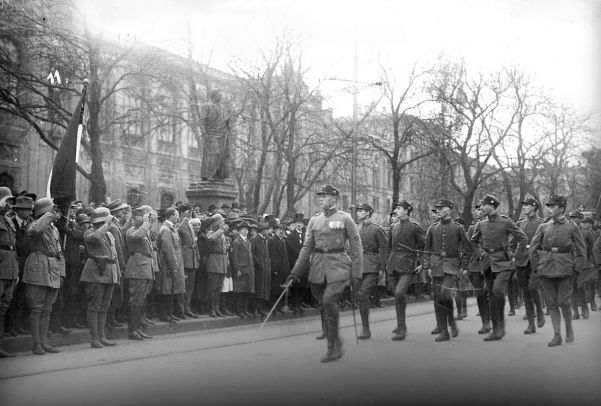
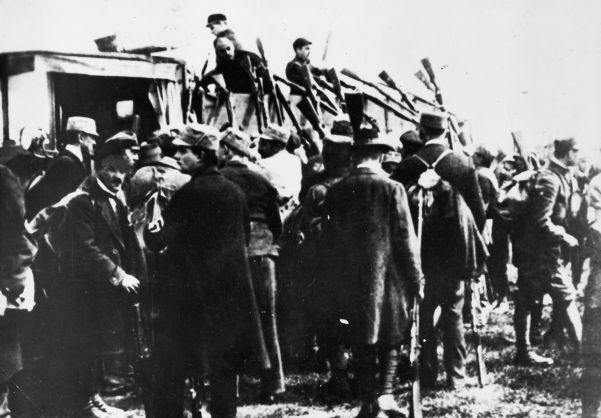

Most of what Hitler said was bluff, though the audience did not know it. Hitler ushered Kahr, General Otto von Lossow and Colonel Hans von Seisser into a side room and announced that they must join him in the new government with General Ludendorff. Hitler then rushed from the room and declared to the stunned audience that the three had agreed to join him in a new government. In a wild sense of euphoria he returned to the three men as General Ludendorff arrived. The latter was in total ignorance of any of the proceedings and was furious that all of this was taking place using his name without his permission. But he supported the general principles of what was taking place and went along with Hitler. In apparent unity they all filed back into the hall. It was now that Hitler made the first of many mistakes, leaving the hall to attempt to settle a disagreement between army engineers and SA stormtroopers that had broken out. Everyone left the hall, including the generals. At the same time the Reichskriegsflagge, the Reich Flag of War, another right-wing organization, was holding a “social” in the Augustiner Beer Cellar, when Ernst Röhm, its commander, was ordered to seize the former Reichswehr ministry in the Leopoldstrasse.
Kahr withdraws
Lossow returned to his own headquarters and began to call up the troops from outlying garrisons. Kahr publicly denounced the whole episode, which should have signalled the collapse of the Putsch. Ludendorff, however, was now heavily committed, and he persuaded Hitler to go ahead with the coup.
On what happened incidentally to be the 124th anniversary of Napoleon’s coup d’état of Brumaire, Hitler had assembled over 2000 men to help him overthrow the Bavarian State government. At midmorning on November 9 they gathered into file and began to march towards the Ludwig Bridge leading to the centre of the city. At the head of the column marched Hitler between Ludendorff, Max Erwin von Scheubner-Richter and Ulrich Graf on one side, and Dr Christian Weber, Gottfried Feder and Colonel Kriebel on the other. Julius Streicher, Nazi rabble rouser, who had been ranting at the crowd in the Marienplatz, joined the second rank. Rosenberg and Albrecht von Graefe, representative of the North German Nationalists and who had come only at Ludendorff’s summons, trudged resentfully along with the rest. Behind the leaders were three units marching abreast in columns of four. On the left was Hitler’s 100-man bodyguard, steel helmeted and armed with carbines and “potato masher” grenades. On the right was the Bund Oberland, a paramilitary organization that had once been a Freikorps, and in the middle was the battle-seasoned Munich SA Regiment. Himmler, carrying the imperial war flag, led the Reichskriegsflagge column. Behind followed a motley collection of men, some in uniform or parts of tattered World War I uniforms, and some wearing work clothes or business suits. The cadets from Infantry School, smart and ultra military, were sandwiched between students, shopkeepers, middle-aged businessmen and hard-faced “Freebooters”. The only common mark among them was a swastika brassard on the left arm.
Farce
From the Marienplatz they turned down the Residenzstrasse towards the Odeonsplatz. Beyond was the old War Ministry where Ernst Röhm with other stormtroopers stood surrounded and impotent. At the end of the street the police were drawn up with carbines. There was only room enough in the street for eight abreast. Hitler locked arms with Scheubner-Richter in preparation for trouble. Ludendorff touched no one, still supremely confident that no one would fire on him. Those who participated claimed the police shot first. Some said Streicher screamed: “Ludendorff! Don’t shoot your General! Hitler and Ludendorff!” Others said it was Graf. At any rate the police fired. Ludendorff was unhurt and marched ahead. Scheubner-Richter dropped to the ground, fatally wounded, pulling Hitler to the ground with him, wrenching the latter’s shoulder as he did so. Ulrich Graf, Hitler’s bodyguard, covered Hitler with his body and received 11 bullets. Kurt Neubauer, Ludendorff’s valet, who had sprung in front of the general to protect him, lay dead, shot in the head. As Hitler sprawled on the ground, thinking he had been shot in the left side, comrades tried to shield him. In all 18 men lay dead in the street, 14 followers of Hitler and four state police (all incidentally more or less sympathetic to National Socialism). The crowd jammed up behind only heard firecracker explosions ahead, but then a rumour spread that both Hitler and Ludendorff had been killed.
Ignominous flight
The Putschists scrambled to the rear; the crowd panicked and fled. Hitler, accompanied by a towering young local physician and chief of the Munich SA medical corps, Dr Walther Schultze (who would later become Reich Leader of Teachers), made good his escape. At Max Joseph Platz they finally reached Hitler’s old grey Selve, and Dr Schultze bundled Hitler into it. After taking various routes of escape and increasing the pain in Hitler’s dislocated shoulder, they took refuge 59km (37 miles) away at Uffing in the Hanfstaengl’s villa (Ernst Hanfstaengl was the only literary member of Hitler’s early inner circle; tall and a practical joker, he became a sort of court jester to the Führer before and after he came to power. He eventually fell out with Hitler and had to flee to the United States to save his life). Göring, also wounded, was carried into another car and driven by his wife Karin across the Austro-German frontier. Röhm surrendered at the War Ministry two hours later. The Putsch ended in a fiasco: the rank and file surrendered their weapons, identified themselves to the police and returned home, while the leaders were arrested. Himmler returned to Landshut where he sold advertising space in the Völkischer Beobachter (The Racial Observer, the official newspaper of the Nazi Party).
The VölkisCher Beobachter
The paper had originally been a weekly sheet devoted to spreading gossip, though immediately after World War I it became more anti-Semitic. In February 1923 Hitler, having raised money with the help of Hansfstaengl, made it a daily newspaper. The chief editor was Nazi racial “expert” Alfred Rosenberg, who filled its columns with anti-Jewish literature. He praised the Nordic race and launched scathing attacks on “coloured subhumanity”. The treasurer of the Völkischer Beobachter, Max Amann, was Rosenberg’s great rival, and they often fought with each other over editorial content. Rosenberg wanted to politicize readers by stressing the Nazi way of life, whereas Amann was only interested in making money for the party. Following the Munich Putsch, the paper ran a front-page headline proclaiming “Hitler’s Triumph”. The issue was priced at eight billion Marks, a reflection of the state of Germany’s currency at the time.
The banning of the NSDAP
The Munich Beer Hall Putsch died with the men who fell in the streets. Though it was a failure, Hitler didn’t consider it as such, but rather a success for what it ultimately achieved. It had created martyrs, and Hitler needed martyrs. The red flag blazoned with a black swastika on a white circular field that had been carried as the emblem and clarion call at the head of the march became another of those Nazi propaganda concepts which walked the fine line between the ridiculous and genuinely effective. The banner, made sacrosanct by the blood of the martyrs of the Putsch, was to become the icon of the party as well as the primary flag of the Nazi movement.
On the same date as the failed Putsch, the General State Commissar issued an order dissolving the NSDAP and stipulated heavy penalties for anyone attempting to carry on the work of the party. The SA and the Stosstruppe Adolf Hitler were banned. Röhm was one of those put on trial; although found guilty of treasonable acts, he was released and dismissed from the army. Shortly afterwards he went to Bolivia to work as a military instructor. Berchtold, the Stosstruppe Adolf Hitler commander, managed to escape to Austria and remain in exile there. On the following day the police searched the headquarters of the NSDAP in the Corneliusstrasse and confiscated everything they could lay their hands on. It was during this difficult period for the Nazi movement that Julius Streicher tried his best to keep the banned NSDAP together as a unit. To evade the ban he set up a new party, the Völkischer-Freiheits-Bewegung.
Streicher founded his own paper in 1923. Entitled Der Stürmer (The Stormer), he later claimed that it was the only paper that Hitler read from cover to cover. Among its more notable “achievements” was the discovery that Jesus was not a Jew. Following the Putsch Streicher worked as a teacher, though he clashed with his superiors on numerous occasions, not least because he insisted that his pupils greet him each day with “Heil Hitler!”. In many ways he was the archetypal Nazi: brutal, violent and sadistic, he advocated the use of force as the solution to any problem. Probably insane, after the war he was tried at Nuremberg, an event he denounced as “a triumph for world Jewry”. Found guilty and condemned to death, his last words on the scaffold were “Heil Hitler!”.
Defeat
The Nazi Party had been defeated and was in disarray, its leaders either arrested or having fled into exile. The Weimar government had seemingly triumphed. The party had 70,000 members in Bavaria before the Putsch, but by the middle of July 1925 this had fallen to 700. The original members had been mostly believers in Völkish ideas, which sought to promote Germanic culture and eliminate the influence of other peoples. The Völkish movement provided the ideological starting point of National Socialism. Hitler wrote in Mein Kampf: “The basic ideas of the National Socialist movement are Völkish and the Völkish ideas are National Socialist.” However, he was keen to stress that the Nazis were different from the numerous discussion groups that existed to debate the finer points of what Völkish actually meant.
The Nazi Party’s Programme, which contained 25 points, provides an example of these Völkish ideas. Point 1 advocated the union of all Germans within a Greater Germany; Point 8 called for the halting of all non-German immigration; Point 19 proposed the replacing of Roman Law, which was materialistic, with “German law”; and Point 23 stated that newspapers must be German-owned.
Though the party had been seemingly destroyed, many thousands still believed in its principles, hence it would be relatively easy to rebuild its power base. This is not to underestimate the task facing senior Nazis in the aftermath of the Putsch. Indeed, the period became known as the Kampfzeit (the “time of struggle”), which later was portrayed as a time of heroes and great deeds. And out of this time, which also included the period before 1923, came the Alte Kämpfer (the “old fighters”), the early members of the Nazi Party who were later revered for their role in the rise of National Socialism. When Hitler gained power the old fighters were given preference for jobs in the Nazi bureaucracy, and those who had been injured in street battles with communists were given the same benefits as the ones allowed to disabled World War I veterans.
Thus was the myth of the Munich Putsch created, which propelled Adolf Hitler onto the national stage. As Hitler was to state: “As though by an explosion, our ideas were hurled over the whole of Germany.” It had been a semi-farcical affair, and had stood little chance of success, even with the revered Ludendorff on board (he had walked right through the police lines on November 9, the policemen having turned their weapons away as a sign of respect). Hitler also learned a valuable lesson: that he would not achieve political power through direct action, especially without the support of the armed forces. He would have to achieve political victory by winning over the masses to his side, plus enlisting the support of wealthy industrialists. In this way he could gain power through legitimate channels.
